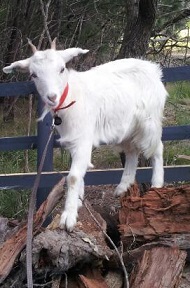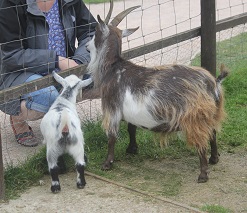
Goats are one of the oldest domesticated animal species. They are close genetic relatives of sheep, both having evolved from a common ancestor, but they are unlike sheep in their behaviour in their natural desire to explore. Sheep on the other hand are neophobic: afraid of everything!
- Goats are ruminant mammals which means they possess a four-chambered stomach. This has relevance when we think of digestive processes in goats.
- They eat mainly grasses, but will graze on a wide variety of plants. They particularly like oats, barley, lucerne (alfalfa), sunflower, linseed, corn, silage.
- Like other ruminant mammals, they have two weight bearing toes on each foot.
- Female goats have an udder, which consists of two teats.
- Most goats naturally have two horns of different shapes and sizes depending on the breed. There are some breeds that are ‘polled’ (genetically hornless) and some may have their horns removed very soon after birth - a common management practice in dairy goat herds to prevent injuries occurring to themselves, other goats, or handlers.
- Both male and female goats have ‘beards’ and some breed also have ‘wattles’ dangling down from each side of the neck.
Goat Health
To quickly identify signs of ill health in goats, it is important to know what to look for in a healthy goat.
The following signs should be monitored on a daily.
- General appearance: bright, alert and inquisitive
- Appetite: interested in food almost any time of day. Excess thirst however is a bad sign.
- Cudding: Goats normally chew the cud after periods of feeding or grazing.
- Eyes and nose: bright eyes, cool dry nose with no signs of discharge.
- Coat: clean and glossy.
- Droppings: firm pellets.
- Urine: light brown with no blood present.
- Body Temperature: 102.5° F-104° F.
- Pulse/heart rate: 60 to 80 beats per minute.
- Respiration rate: 15 to 30 breaths per minute.
- Movement: steady gait with all four feet taking weight as goat walks.
- Milk Yield: Sudden changes should be noted.
- Reproductive signs: goats on heat
Any deviations from the above points may indicate that the goat is unwell and in need of attention. The problem may be nutritional or due to diseases.
Hoof Care
Periodic foot trimming is more often required for goats kept on soft or smoother ground. Foot trimming may begin when kids are a month old, and repeat from every 6 weeks to every 3 months, depending on each animal (some animal's hooves grow faster than others). It is advisable to employ a specialist in foot trimming if you're not familiar with this procedure.

Disbudding
Disbudding is thought by some to be an inhumane process. The process consists of burning the horn buds off when the kid is 3-7 days old; it involves the cauterization of nerve supply to the horn bud before it really begins to grow. The most common method for disbudding is with an electric disbudding iron. Disbudding can be a very dangerous and life threatening practice, however, if the procedure is done properly before the kid’s nervous system has entirely matured, it can be an easy and harmless procedure, as well as a quicker healing process.
Dehorning
This process refers to the removal of grown or growing horns in an older goat. Horns have a very good blood and nerve supply so removing them once they are grown is not a good thing to do unless necessary. The horns are an integral part of the goat’s skull, and when removed the risk of infection is extremely high. If this process must be carried out, it should always be carried out by a qualified and experienced veterinarian who will carry out the procedure under anaesthetic.
Tattooing
Tattoos are used as positive means of identification for a goat. Many breed societies insist that a goat is tattooed before it can be registered in their stud book. Tattoos are normally applied soon after birth to ensure lifelong identification. Depending on the breed, they can be applied to the goat’s ears or if they are a breed with very small ears the tattoo can be applied to the tail web area. Tattoo symbols are normally split up into a herd identifier (which remains the same for all kids born on that property) and then a specific animal identifier, which identifies the year of birth followed by a sequential number that identifies the particular animal.
Vaccination
Routine vaccinations are an important part of the management of a flock of goats. Vaccinations will protect against disease and ensure the flock remains healthy. The most important vaccinations given prevent against Clostridial bacteria, enterotoxaemia (Pulpy Kidney Disease) and additionally tetanus. Most vaccinations are administered subcutaneously (under the skin) so can be given by the herd owner if they are confident to do so. Care should be taken to adhere to any withdrawal periods for milk and meat after vaccinating.
Some general health care reminders:
- Remember to drench (de worm) to control internal parasites.
- Spray or dip to control external parasites such as mites (and where applicable ticks).
- Isolate sick animals.
- Record all vaccinations, parasite controls and any other medications administered.
- Remember foot trimming is important to help prevent foot related ailments such as foot rot.
- Provide fresh clean water always.
- If you're unsure about anything – call a large animal vet!
Housing and Fencing Requirements
Goats prefer drier hilly country (wet conditions are not desirable). They need direct sunlight, but also shelter from excessive heat. They require protection after shearing, but are otherwise hardy. They are susceptible, however, to respiratory diseases so some type of shelter is essential. This may be an appropriate goat shed or a simple “A” frame construction in the paddock.
Housing and appropriate facilities for a flock of goats may be adapted from original buildings already on the property or they can be purpose built. A small size flock of goats can be managed without elaborate facilities.
There are two main methods for housing goats. The first is to keep them mainly out on pasture and to provide them with shelter within the grazing area. The other method is to keep the goats in a shed or small barn with a fenced yard for exercise. This second method is used mainly for dairy and fibre goats or by farmers who don’t have access to sufficient amounts of pasture.
The basic requirements of safe and suitable goat housing are:
- A dry, draught free building with sufficient headroom, which allows the goat to stand upright on its hind legs with its neck outstretched. The building should also have sufficient headroom for goat keepers to stand up in. Pen and door heights vary according to breed; greater/less height is necessary for some breeds of goats. 1.3 m high is a recommended average.
- If separate pens are provided for each goat then they should have at least 4m2 of floor space. Certain types of goats, like dairy goats, get cold very easily. If floors are made from concrete, they will require a thick layer of bedding. Wooden floors can be warmer, but they will absorb urine and eventually rot if highly absorbent bedding isn’t used and frequently changed. Crushed limestone may be a good option for floors, but it can be expensive and it may become impermeable through time because the stones may crush against each other and become very compact. The most ideal flooring is said to be dirt because they are easier to maintain, it soaks excess urine and less bedding is required, as well as providing a more warm and comfortable environment for the animal.
- Individual pens can be fitted with hay racks, feed and water buckets and bucket holders. Bucket holders are useful for preventing feed and water buckets being tipped over and they should be appropriately placed to avoid contamination with urine and feces. There should be an enough space for all goats to access feeding areas - this helps to prevent bullying.
- Goats are social animals and like to see each other, so provision needs to be made for this in the type of dividing partitions used.
- A well-fenced exercise area is needed, which is at least three or four times the size of the pens. Ideally the exercise area needs to be concreted or have a similar hard surface that does not retain moisture and that can be easily cleaned. Alternatively, the goats can be turned out to graze in a well fenced paddock. A field shelter of some description is also a good idea.
- If bucks are kept, they need to be housed completely separately from the does and kids.